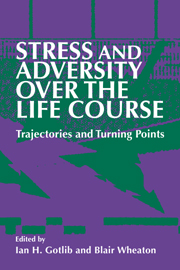Book contents
- Frontmatter
- Contents
- List of contributors
- 1 Trajectories and turning points over the life course: concepts and themes
- I Trajectories: long-term effects of adverse experience
- 2 Childhood adversity and adult psychopathology
- 3 The impact of twenty childhood and adult traumatic stressors on the risk of psychiatric disorder
- 4 Intergenerational sanction sequences and trajectories of street-crime amplification
- 5 School-leavers' self-esteem and unemployment: turning point or a station on a trajectory?
- 6 Intergenerational consequences of social stressors: effects of occupational and family conditions on young mothers and their children
- 7 Women's roles and resilience: trajectories of advantage or turning points?
- II Turning points: changes in life trajectories
- III New methods for the study of the life course
- Index
6 - Intergenerational consequences of social stressors: effects of occupational and family conditions on young mothers and their children
from I - Trajectories: long-term effects of adverse experience
Published online by Cambridge University Press: 23 October 2009
- Frontmatter
- Contents
- List of contributors
- 1 Trajectories and turning points over the life course: concepts and themes
- I Trajectories: long-term effects of adverse experience
- 2 Childhood adversity and adult psychopathology
- 3 The impact of twenty childhood and adult traumatic stressors on the risk of psychiatric disorder
- 4 Intergenerational sanction sequences and trajectories of street-crime amplification
- 5 School-leavers' self-esteem and unemployment: turning point or a station on a trajectory?
- 6 Intergenerational consequences of social stressors: effects of occupational and family conditions on young mothers and their children
- 7 Women's roles and resilience: trajectories of advantage or turning points?
- II Turning points: changes in life trajectories
- III New methods for the study of the life course
- Index
Summary
The notion of a trajectory involves some patterned movement of a single object across space and time, and evokes images of inanimate objects, propelled by powerful forces, streaking across the night sky in a dramatic and predictable arc. In the sociology of the life course, we are more concerned with animate human actors whose trajectories are more subtle and who are more readily “bumped” off-course; but we nevertheless typically maintain that they are indeed propelled by powerful social forces that constrain, even if they do not completely determine, the shape of their lives. It is precisely because continuing in the same direction in which one is already headed is so much expected, in fact, that we find the exceptions interesting. We are fascinated, as social scientists and as fellow travelers from cradle to grave, when people appear to dramatically shift course, get “derailed” or “jump off the track,” reinvent themselves and their daily lives, and reshape their future prospects. In comparison, we tend to be less interested in that which makes these exceptions remarkable – the strong persistence over time, for most people, of their current circumstances. Thus, dramatic turning points are foregrounded while trajectories are backgrounded. In the social stress literature, a similar emphasis can be seen in the preoccupation with life events to the relative neglect of chronic, persistent social conditions.
- Type
- Chapter
- Information
- Stress and Adversity over the Life CourseTrajectories and Turning Points, pp. 114 - 132Publisher: Cambridge University PressPrint publication year: 1997
- 5
- Cited by



